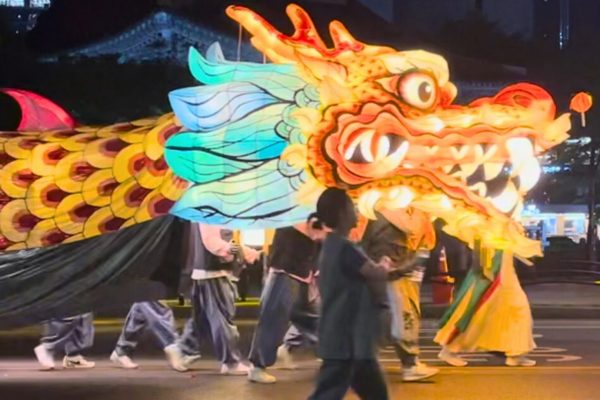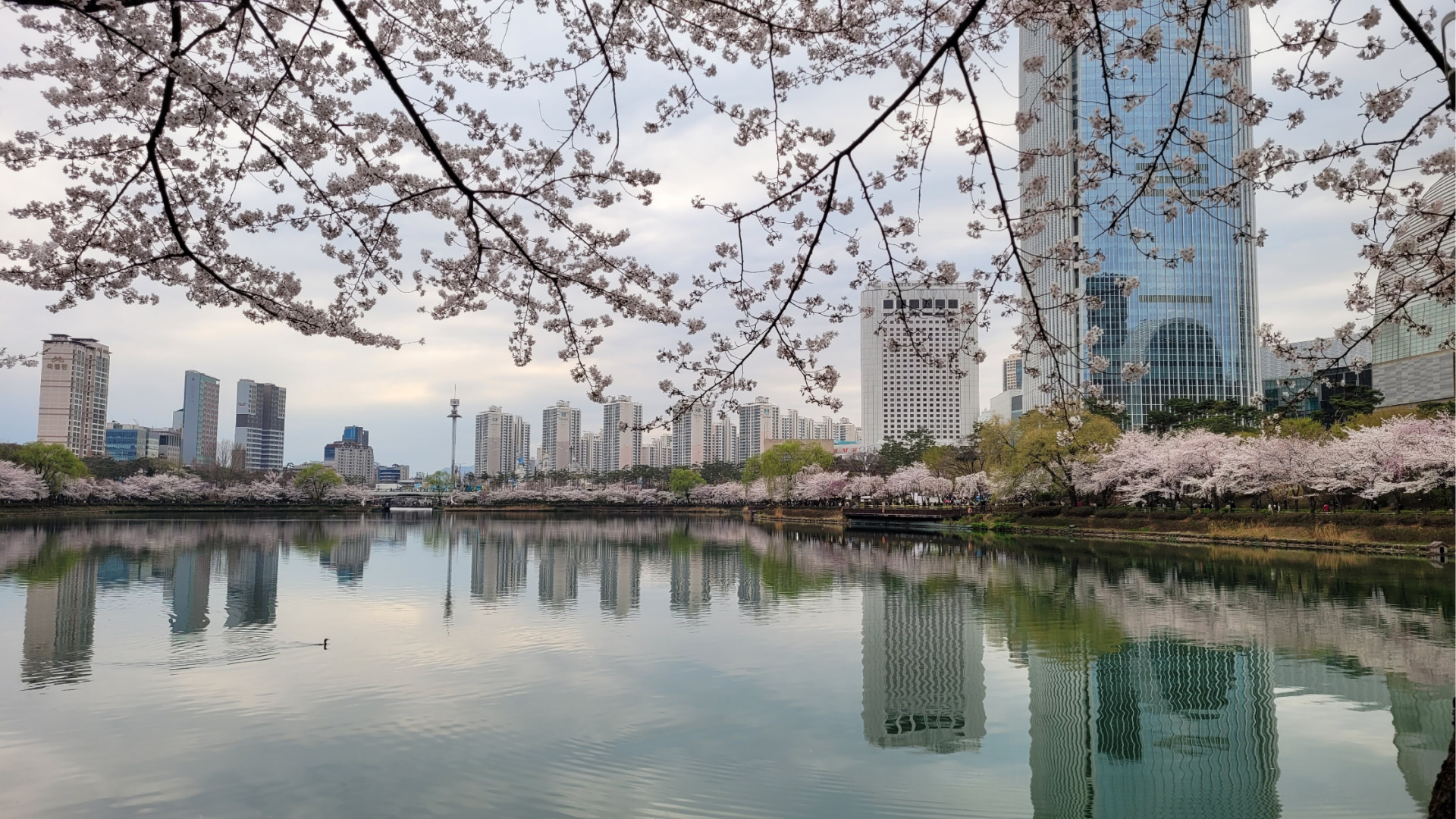What’s the best season to visit South Korea? The country has something to offer year-round, from the soft pink cherry blossoms of spring to the fiery autumn leaves, the sunny beaches in summer, and the cozy charm of winter festivities. Each season brings its unique charm and challenges. Whether you’re a nature enthusiast, a city explorer, or a beach lover, choosing the right season can make all the difference in crafting the perfect adventure.
So let’s break down the pros and cons of visiting South Korea in each season to help you choose the ideal time for your trip, including tips on what to expect, what to pack, and important holidays that might affect your itinerary. By the end of this guide, you’ll have a clear idea of the best season for your trip to South Korea, tailored to your interests and preferences.

The best season to visit South Korea
Spring (March to May) 🌸
Spring in South Korea is all about fresh blooms, mild temperatures, and a festive atmosphere. As the country shakes off the winter chill, it becomes a popular time to enjoy outdoor activities, festivals, and, of course, the famous cherry blossoms.
Pros:
- Cherry Blossoms: Spring is famous for its cherry blossoms, transforming cities and parks into pastel wonderlands. Peak bloom varies yearly but typically falls between late March and early April.
- Mild Weather: Temperatures are pleasant, making it ideal for outdoor sightseeing without the intense heat or bitter cold.
- Festivals Galore: Spring hosts various festivals, including the Jinhae Cherry Blossom Festival and the Lotus Lantern Festival in Seoul.
Cons:
- Crowds: Cherry blossom season is popular, so you’ll encounter crowds, especially in top tourist spots.
- Allergy Alert: If you’re sensitive to pollen, this might not be the best time as pollen levels can be high.
- Air Quality: Unfortunately, Spring is high season for bad air quality, e.g. make sure to have a face mask on hand.
Things to Keep in Mind:
- School Trips: Korean students often go on field trips in spring, so you might see groups of students at popular attractions.
Ideal for Travelers Who:
- Love mild weather, are excited about cherry blossoms, and want to experience the festive vibe.

Summer (June to August) ☀️
Summer is the time for beach lovers and night-market explorers, as South Korea’s coastal and city life truly heats up. The season brings warmth, but it also comes with some rain—so pack accordingly and embrace the lively summer energy!
Pros:
- Beach Season: The beaches, especially in Busan, come to life. Festivals like the Haeundae Sand Festival make summer a lively time for beach lovers.
- Night Markets: Summer nights are perfect for visiting bustling night markets and tasting street food like tteokbokki and hotteok.
Cons:
- Hot & Humid: Temperatures can reach up to 35°C (95°F) with high humidity, making outdoor activities uncomfortable.
- Rainy Season: Monsoon season (early July to mid-August) brings heavy rainfall, so be prepared for sudden downpours.
- Peak Vacation Time: August is a vacation month, so prices may be higher, and attractions can be more crowded.
Things to Keep in Mind:
- Monsoon Season: Pack waterproof gear, and have indoor activities (e.g. museums) as a backup plan.
- School Holidays: With summer break, you may find more local families and students at attractions.
Ideal for Travelers Who:
- Love summer vibes, don’t mind the heat, and are excited about beach days and vibrant nightlife.

Fall (September to November) 🍁
Fall in South Korea is a dream come true for nature lovers. As temperatures cool, the landscapes transform with stunning foliage, making it an ideal season for outdoor adventures and cultural experiences.
Pros:
- Stunning Foliage: Korea’s fall foliage is breathtaking, with parks, mountains, and temples framed by shades of red, orange, and yellow.
- Perfect Weather: With cooler temperatures and low humidity, fall offers comfortable days for hiking and exploring.
- Harvest Festivals: Chuseok, Korea’s version of Thanksgiving, is celebrated in the fall. You might experience cultural events or see locals wearing hanbok (traditional clothing).
Cons:
- Holiday Closures: Chuseok means many businesses close for a few days, so some services may be limited.
Things to Keep in Mind:
- Chuseok Dates: Chuseok is celebrated based on the lunar calendar, so check dates beforehand as flights and hotels may be pricier.
Ideal for Travelers Who:
- Enjoy mild weather, want to experience Korea’s natural beauty, and are interested in cultural festivals.

Winter (December to February) ❄️
Winter turns South Korea into a cozy wonderland, especially if you love skiing or snowboarding. While temperatures drop, festive lights and holiday markets create a magical atmosphere, and there’s plenty of winter street food to warm you up.
Pros:
- Winter Sports: South Korea has top-notch ski resorts like Yongpyong and Alpensia, ideal for snow enthusiasts.
- Unique Festivities: Winter is a cozy season filled with celebrations, including the Seoul Lantern Festival and various Christmas events.
- Hot Food: Korean winter street food is perfect for cold days. Imagine enjoying steaming hot tteokbokki or fish cakes on a chilly night!
Cons:
- Freezing Temperatures: Winters are cold, especially in the north. Seoul temperatures can drop below -10°C (14°F).
- Shorter Days: Fewer daylight hours mean limited time for sightseeing.
Things to Keep in Mind:
- Winter Sports Demand: Book ski resorts in advance as they’re popular among locals and tourists.
Ideal for Travelers Who:
- Love winter sports, are interested in holiday festivities, or prefer fewer crowds at top tourist spots.

How to Choose Your Ideal Season?
To figure out the best season for your trip, ask yourself these questions:
- What activities are most important to you? Are you a beach person, a city explorer, or someone who loves nature and scenic hikes?
- How much do you mind crowds? Cherry blossom season and fall foliage attract more visitors. If you prefer quieter times, winter might be better.
- What’s your comfort zone for weather? If you don’t mind the heat, summer has unique experiences, while spring and fall offer milder temperatures.
- Are you interested in local festivals or cultural experiences? Look into dates for events like Chuseok or the Jinhae Cherry Blossom Festival.
Each season offers its own unforgettable experience in South Korea, so it’s all about finding what fits your travel style best and what’s the best season for you to visit the country. Whether you’re strolling through cherry blossoms, basking on beaches, or hitting the slopes, South Korea is ready to impress year-round!
What is your personal best season to visit South Korea?
Interested in learning more about Korean culture? Check out my blog posts about Dancheong, making your own DIY souvenirs, Korean Culture with a Twist, Lotus Lantern Festival, and Traditional Children’s Games as seen on Squid Game.
Also, on my blog, you can find a post on 5 must-download apps before your trip to South Korea as well as a free printable travel prep checklist.
Are you traveling to South Korea?
Get your eSIM via Saily* to have unlimited data while on vacation and check out NordVPN* to stay protected online or watch your Netflix shows available in your home country. 😉
*Affiliate link: I get a commission if you decide to make a purchase through my links, at no additional cost to you. 🙂
Auf Deutsch, bitte? Hier gibt’s den Blog-Post auf Deutsch.



